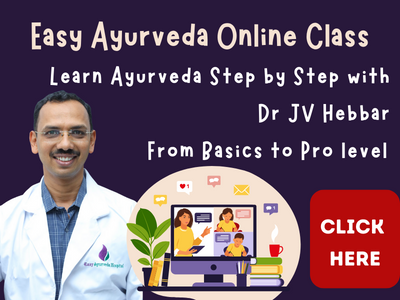Article by Dr Raghuram Y.S. MD (Ay) & Dr Manasa S, B.A.M.S
The procedure of undergoing Rasayana Therapy is not an easy one. It is a journey of discipline, patience, integrity, courage, determination and trust in the process. This is especially so in the case of ‘Kuti Praveshika Rasayana’ method which is very difficult therapy to undergo and it demands utmost submission and volunteering into the process.
Being in the context, Rasayana, based on the method of administration, has been classified broadly into two kinds.
- Kuti Praveshika Rasayana Vidhi – This is a method wherein a person who has undergone Shodhana – purificatory procedures enters a customized cottage and stays there with an intention of taking Rasayana. He will be served by the consulting physician at home and the medical team but it is a disciplined isolation wherein he or she does not get to meet or interact with anyone and are kept detached from worldly affairs. It is a closed method of taking Rasayana – ‘the indoor rasayana’. This procedure is tough to follow and comes with many restrictions. This is said to be the best method of administering / taking Rasayana Therapy and has many advantages over the other types / types including the benefits it bestows.
- Vatatapika Rasayana Vidhi – Here the person need not stay in a cottage and can take Rasayana Therapy while attending to his day-to-day chores and enjoying his normal life while following essential and minimal restrictions. This is comparably an easy method of taking Rasayana but not as effective as the former one. This may be conveniently customized and the method of taking this Rasayana will differ from person to person. It is an open method of taking the Rasayana – ‘the outdoor rasayana’.
Related Reading – ‘Kuti Praveshika Rasayana Vidhi’
Related Reading – ‘Vatatapika Rasayana Vidhi’
Eligibility for Rasayana Therapy
समर्थानामरोगाणां धीमतां नियतात्मनाम् |
कुटीप्रवेशः क्षणिनां परिच्छदवतां हितः ||२७||
अतोऽन्यथा तु ये तेषां सौर्यमारुतिको विधिः |
तयोः श्रेष्ठतरः पूर्वो विधिः स तु सुदुष्करः ||२८||
Ref – Charaka Chikitsa Sthana, Chapter 1, Quarter 4, Verses 27-28 (Cha.Chi.1.4/27-28)

The eligibility criteria for Rasayana explained by Acharya Charaka in this context mainly pertain to those who are planning to undergo Kuti Praveshika type of Rasayana. The second part of the verse explains the eligibility criteria for Vatatapika Rasayana.
- Eligibility / suitability for Kutipraveshika type of Rasayana Therapy
- Samartha – Capable
The person who is planning to undergo Kutipraveshika Rasayana should be capable enough to accumulate all the necessary things well in advance of the therapy. He should be rich and financially stable enough to meet the expenditures of this Rasyana Therapy since the entire procedure is a very costly affair. This term also reflects ‘adhyo rogi’ i.e. ‘the patient should be wealthy’ one of the characteristic features of an ideal patient explained in Chikitsa Chatushpada context (four limbs of the treatment wherein the patient is one among the four limbs). Certain therapies are designed only for wealthy people and some are so costly that a common man cannot afford to take those therapies, treatments or medicines.
The patient / person who is planning to undergo this form of customized Rasayana therapy will incur expenses towards –
– Preparatory procedures including Panchakarma, which are mandatory procedures before conducting Rasayana therapy. Rasayana therapies bestow best results only in those who have undergone purificatory therapies (shodhana, panchakarma), else they would fail in providing essential benefits.
– Customization of Kuti – cottage or personal chamber and its construction in an ideal place and on its engineering so that everything inside and outside it is ready for him or her to stay therein and experience Rasayana Therapy. He should also be bearing the expenses required towards paying the laborers and engineers who are involved in the construction of kuti.

– Collection of equipment and medicines required for Rasayana Therapy.
– For paying the doctors, medical staff and priests and all helpers.
This treatment cannot be and should not be taken by those who are not capable of getting these things prepared and equipped.
Aroga – those who are ‘disease free’
One should be absolutely healthy / disease free to undergo Rasayana therapy. Having a disease means having disturbance of one or the other type inside the body, that one or more of the doshas are aggravated in the body, that there is ama in the body, that there are blocks in the channels of the body, that there is accumulation of malas – excreta in the body, that the agni is in a state of imbalance and there is unpleasantness of mind, senses and soul. In these conditions wherein the body is filled with impurities, the Rasayana would not be absorbed and utilized to optimum proportions and would prove to be waste.
Ayurveda explains this with the help of an analogy. Just like the painting done on a dirty canvas does not look attractive, the Rasayana and Vajikarana therapies administered in a dirty body i.e. body which has impurities in it, too will be futile and will not yield desired benefits.
So, only the person who has undergone purification therapies and has got rid of his diseases and is completely healthy should plan to take Rasayana Therapy.
Dheematam – those who are intellectual / intelligent
One should have not only intelligence to understand the process of taking Kuti Praveshaka Rasayana and the significance of religiously following each and every rule and regulation associated with the process for tapping good benefits out of the therapy, he or she also should have presence of mind and get involved into the process. This happy volunteering into the therapy will keep the person conscious and connected to the rituals and procedures of this formatted and customized Rasayana Therapy which is otherwise very difficult to accept, commit and follow. Trust and acceptance of the treatment procedures will add to psycho-somatic healing and will add to the results and benefits one is believed to get from these therapies. On the other hand, if the person is not intelligent, conscious or committed, the entire setup and design of the therapy may look strange and weird to him or her. Either they would not accept to undergo this process or would back-out in between the therapy.
Niyata Atmavan – always self controlled
This feature is an extended version of ‘dheematam’. While committing to undergo ‘Kuti Praveshika Rasayana’ therapy, one should always be ‘self controlled’. There are so many restrictions which come along with isolation from the world and staying alone in the kuti – specially designed cottage for Rasayana Therapy – for many days. Those who are not self-controlled would easily deviate from the advice and restrictions and do what they want to, instead of what they need to. These persons are not eligible for undergoing Rasayana Therapy. While the patient does not get the desired results, the physician and the medical team will get a bad name and reputation due to the misconducts of the patient. It is also a waste of time, money and energy to design Kuti Praveshika Rasayana Therapy for those who do not have self control. Those who have self-control and are disciplined too should be habituated towards these good practices and not limit them only for the time period during which they undergo the therapy.
Kshaninam – those who have time to spare
Many people say that they do not have time to undergo therapies. It is difficult to convince them about the immense benefits of therapies like Kuti Praveshika Rasayana. So, volunteering is a rarity in these cases. If one does not have time for their own health and ‘self care’ their time is not worth anything. Even if these people are convinced into undergoing the therapy, they will not be disciplined because they have other priorities and their focus is diverted towards them. In these cases, Kuti Praveshika Rasayana would become a formality which would not yield anything beneficial. So, these people are ineligible for Rasayana therapy. They may not be entertained to undergo the same. If Rasayana Therapy is mandatory for these people, the next best option will be ‘Vatatapika Rasayana’.
The other version for Kshaninam has been mentioned as ‘kshaminam’ i.e. persons who can forgive. Forgiving is the greatest feature of humanity. If they can do that, they are kind hearted and good human beings. It shows the Sattvika nature of their mind, attitude and personality. Kuti Praveshika Rasayana would work the best in these people since they would follow every inch of the instructions passed on to them and hence eligible for the therapy.
Parichchadavatam – those who are well off / well to do
This explanation is an extension over ‘Samarthanam’ explained in the beginning of this article. Financial stability and being able to spend money is the key criterion for undergoing ‘Kuti Praveshika Rasayana’ since the entire process is very costly. So, one should be wealthy to undergo these therapies. Kuti Praveshika Rasayana is not for everyone. Being wealthy has a broader meaning. The person should be wealthy with good and caring friends and family members (though they are not allowed into the Kuti while the therapy is carried out), to help the person to undergo Rasayana therapy and also to take care of him or her post-therapy so that they enjoy long-standing benefits of Rasayana. Being wealthy is also to have good qualities and features and be bestowed with everything good.
Eligibility / suitability for Vatatapika / Saurya-Maruta type of Rasayana Therapy
The persons with the above said qualities / features / equipment, as explained in the ‘eligibility for Kuti Praveshika Rasayana’ are considered as eligible to undergo Kuti Praveshika Rasayana. Those who do not fulfill these criteria will not be qualified (unfit) to undergo the same.
Those persons can be considered eligible for undergoing Saurya-Maruta or Vatatapika Rasayana. All persons who are unfit or not eligible to undergo Kuti Praveshika Rasayana due to non-fulfilling of the required criteria or due to some other reason are eligible for Vatatapika Rasayana.
The criteria would be –
– Asamartha – those who do not have the capability to undergo Kuti Praveshika Rasayana can be subjected to Vatatapika Rasayana.
– Rogi – persons who are not completely healthy and have one or the other disease or dosha aggravation. In these persons, disease specific treatment should be given first and later Vatatapika Rasayana for maintenance of health and immunity. Rasayana of either type should not be given for those who have active disease in them.
– Adheematam – Vatatapika Rasayana will also suit those who are not very intellectual enough to understand the concept and application of Kuti Praveshika Rasayana or who cannot be convinced to undergo the same. These people may not prefer to take either kind of therapies also.
– Aniyata Atmavan – Those who do not have self-control should either not be advised to undergo Rasayana therapy or should be advised to take Vatatapika Rasayana if need be.
– Akshaninam – Those who do not have much time for undergoing Kuti Praveshika Rasayana are ideal candidates for Vatatapika Rasayana.
– Aparichchadavatam – Vatatapika Rasayana is ideal for those who do not have sufficient wealth to undergo Kuti Praveshika Rasayana. It is also true in the case of those people who do not have people – friends and family – to take care of them or support them.
Note – Among both types of Rasayana i.e. Kuti Praveshika and Vatatapika types of Rasayanas, the former one i.e. Kuti Praveshika Rasayana, though very difficult to undergo, is said to be the best one.

